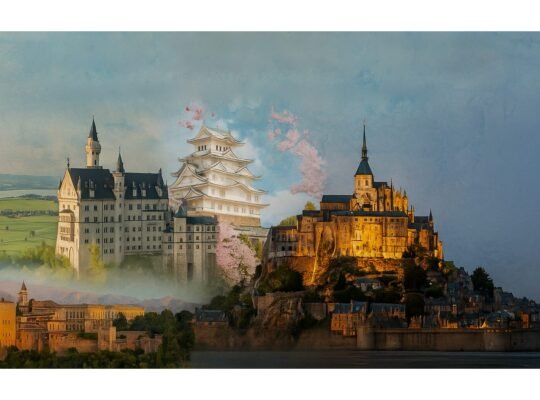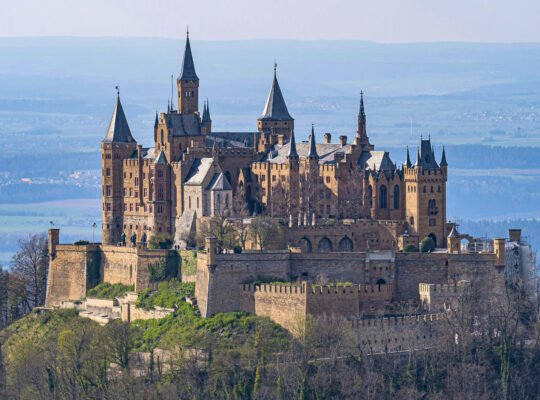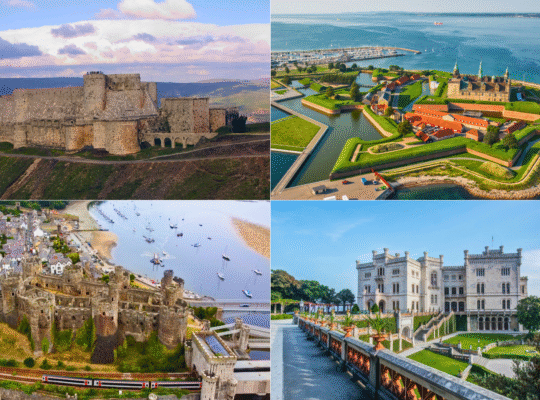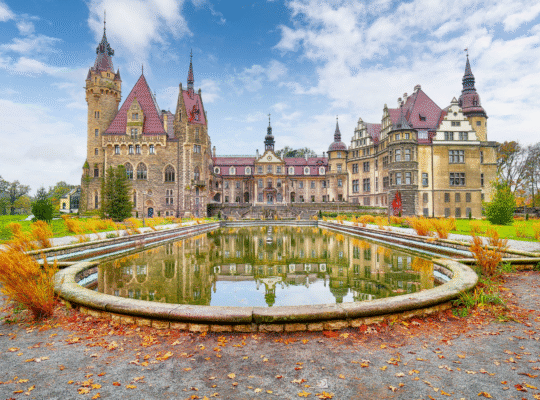You know that feeling when you stand in front of something so massive, so ancient, and so meticulously crafted that you’re not sure whether to be amazed or just speechless? That’s exactly how I felt the first time I laid eyes on Malbork Castle. Towering over the sleepy Nogat River in northern Poland, this red-brick behemoth is like something straight out of a medieval epic — minus the dragons, of course (though the stories here come pretty close).
They say it’s the largest brick castle in the world. True. But to me, Malbork felt like much more than just the biggest — it felt like walking into a living, breathing chronicle of Europe’s Middle Ages. A place where power, religion, ambition, and mystery still echo between its towering ramparts.
So if you’re planning a visit, or even just dreaming of one, let me take you on a journey through one of Europe’s most unforgettable fortresses.
Quick Look: What Makes Malbork So Special?
📍 Where: Malbork, northern Poland, Pomeranian Voivodeship
🏗️ Built: Construction began in 1274, expanded over the 14th century
🏰 Architecture: Brick Gothic — bold, austere, and dramatic
👑 Historic Tenants: The Grand Masters of the Teutonic Order
🎯 Claim to Fame: World’s largest castle by land area
🏆 UNESCO Status: Yes, since 1997 as the Castle of the Teutonic Order in Malbork
🌐 Website: https://zamek.malbork.pl
From Crusader Ambitions to Polish Pride
A Fortress Born of Faith and Force
Let’s rewind to the 13th century. The Teutonic Knights — imagine a mash-up of monks and warriors — were sent to northern Europe with a holy mission: convert the Baltic pagans or conquer them trying. They chose the latter more often than not.
In 1274, they laid the foundation for Marienburg (“Mary’s Castle”), what we now know as Malbork. Its position along the Nogat River wasn’t just pretty — it was strategic. The river fed into major trade routes, and the nearby Vistula River connected the castle to the Baltic Sea.
And so began the rise of what would become one of the greatest strongholds in all of Europe.
The Teutonic Super-Castle
Fast forward to the 1300s. The Order was flush with wealth, power, and ambition. They moved their capital from Venice to Malbork, and the construction kicked into high gear. The result? A triple-fortified masterpiece with distinct zones:
• The High Castle, home to the knights’ spiritual and monastic quarters.
• The Middle Castle, where the Grand Master held court.
• The Outer Bailey, the heartbeat of castle life, with workshops, granaries, and stables.
At its peak, Malbork wasn’t just a fortress — it was a city in itself, housing thousands and wielding influence across Central Europe.
Enter the Poles
After years of wars and political turmoil, the Polish crown took Malbork in 1457. For the next few centuries, the castle played various roles: royal residence, barracks, and later, a Prussian outpost after Poland’s partitions.
It saw destruction during the Napoleonic Wars, fell into romantic ruin in the 19th century, and was bombed heavily in WWII. Yet, like Poland itself, it rose again — meticulously rebuilt brick by brick by Polish conservators.
Today, Malbork isn’t just a monument; it’s a national treasure.
“It’s not just what you see — it’s what you feel. The silence in the chapel, the echo of footsteps in the refectory — this place speaks.”
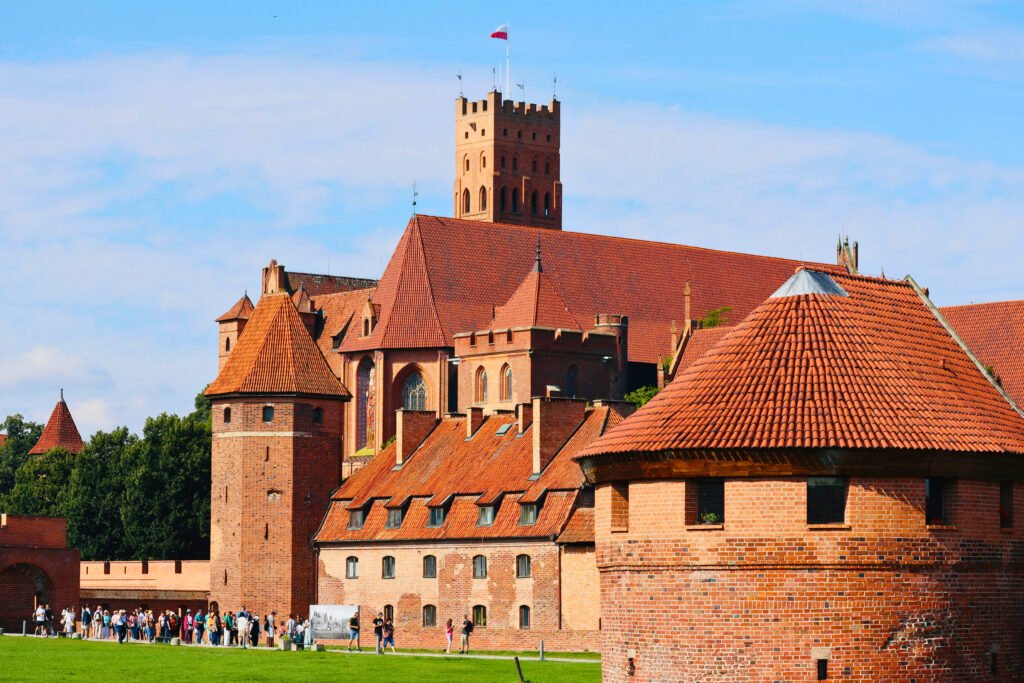
A Fortress of Function and Form: The Architecture of Malbork
Why Brick Gothic Rocks
Stone was scarce in this part of Poland, so the Teutonic builders turned to brick. The result? A distinctly northern Gothic look that’s both austere and grand.
Expect red-brick towers that pierce the sky, ribbed vaults that soar above your head, and a layout that’s as functional as it is intimidating.
Can’t-Miss Highlights
🏰 The Grand Master’s Palace: Think medieval luxury — tiled ovens, vaulted ceilings, and some of the finest Gothic halls you’ll find anywhere.
🕍 St. Mary’s Church: Heavily damaged in WWII, now painstakingly restored. Look for surviving frescoes and the Grand Masters’ tombs.
🍽️ The Refectory: This is where knights once dined. It’s massive, echoing, and utterly atmospheric.
🧱 Defensive Mastery: Moats, murder holes, drawbridges, bastions — Malbork was a fortress built for siege warfare, and it shows.
A Restoration Epic
After WWII left Malbork in ruins, historians and architects turned to everything they had — old photographs, maps, sketches, even 19th-century postcards — to bring it back. The reconstruction effort is still hailed as one of the most successful heritage restorations in Europe.
Today, it houses one of Poland’s best historical museums, complete with:
• Armor and weapons
• Religious relics
• Medieval art and manuscripts
• Amber treasures (a regional specialty)

Stories in the Shadows: Myths, Ghosts, and War-Time Whispers
No medieval castle is complete without a good haunting. Malbork obliges.
The Ghost Knight
One of the castle’s most famous legends speaks of a fallen Teutonic knight, doomed to patrol the halls for eternity after betraying his comrades. Some visitors claim they’ve seen his shadowy figure in the Grand Master’s chamber — or heard the faint clang of boots in empty corridors.
Secret Tunnels and Hidden Gold
Folklore says a secret passage connects Malbork to nearby Sztum Castle, possibly used to ferry treasure or escape enemies. Others believe Nazi forces hid documents and valuables within Malbork’s walls during WWII. Nothing definitive has been found, but the stories refuse to die.
Ringing the Bell at Midnight
There’s an old superstition that if the castle’s bell rings at midnight during a full moon, a portal opens to the past. Locals tell tales of hearing whispers or seeing lantern lights flickering in the High Castle’s windows. Coincidence? Maybe.
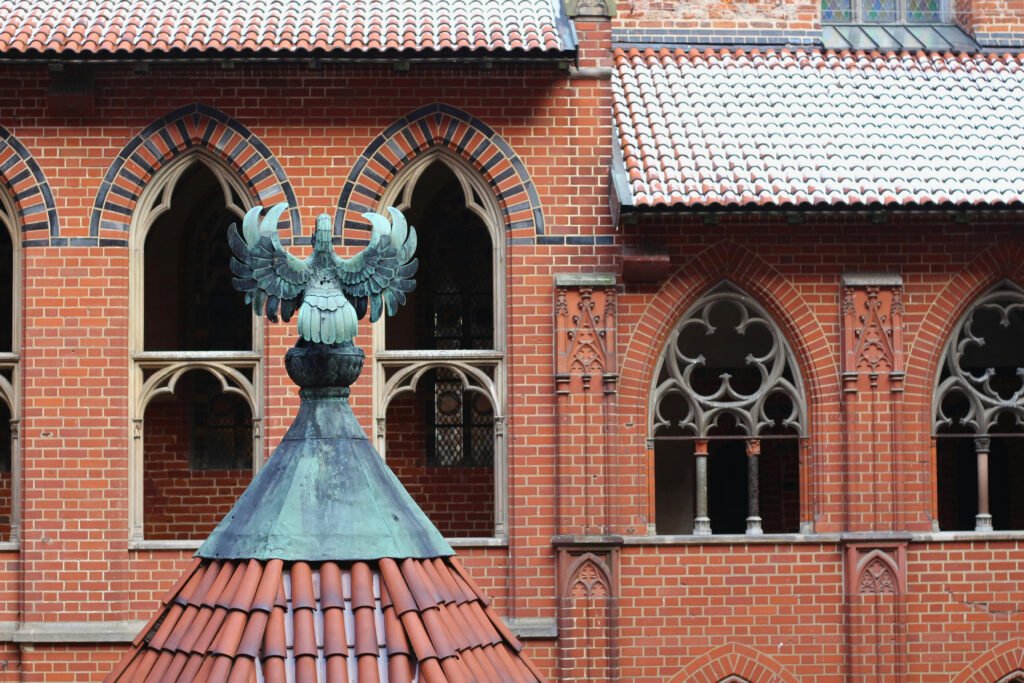
Visiting Malbork Castle: What You Need to Know
When to Go
🌸 Spring (April–June): Best for quiet strolls and blooming gardens.
☀️ Summer (July–August): Peak season. Great for reenactments and festivals.
🍁 Fall (Sept–Oct): Stunning autumn colors and fewer crowds.
❄️ Winter: Less access, but magical under snow. Think snowy ramparts and hot mulled wine.
Getting There
🚆 From Gdańsk: Direct train (~50 mins). The castle is a 10-minute walk from the station.
🚗 By car: Via national road 22, with ample parking nearby.
🛥️ By boat: Some seasonal cruises include Malbork as a stop. Highly scenic!
Tickets & Tours
🎫 Basic Entry: Around 70 PLN (approx €16)
🎟️ Combo Ticket: Museum + exhibitions + castle grounds
🎧 Audio Guide: Multilingual, highly recommended
🌙 Special Tours: Night walks, torchlit reenactments, summer theatrical events
Tips from My Visit
🥾 Bring good walking shoes. The grounds are big, and there are lots of stairs.
📅 Book your tickets in advance during summer.
⏳ Plan for at least 3–4 hours (more if you’re a history nerd like me).
🍺 Grab a bite in the on-site restaurant. I had pierogi and a cold Polish beer — and it was glorious.
🛍️ Don’t skip the gift shop! Locally made amber and knight-themed keepsakes await.

What to See Around Malbork
🏰 Sztum Castle: Just 15 km away, this lesser-known Teutonic fortress is quieter and great for a short trip.
🌆 Gdańsk: Charming, historic, and full of character. Don’t miss the WWII Museum or a walk along the Motława River.
🦢 Vistula Lagoon: Serene area ideal for nature walks, boat rides, and birdwatching.
🛶 Elbląg Canal: Yes, it literally lifts boats over land on tracks. One of Europe’s quirkiest engineering feats.
🍽️ Eat Like a Local
• Bigos: A hearty hunter’s stew — perfect after walking the ramparts.
• Placki ziemniaczane: Crispy potato pancakes often served with sour cream.
• Malbork Mead: Sweet, strong, and historic.

Why Malbork Left a Mark on Me
I’ve seen castles that felt staged. Malbork didn’t. It felt powerful. Real. Like a place that mattered — and still does.
It’s easy to get lost in the grandeur of the place. The red-brick walls that seem to glow at sunset. The silence in the vaulted chapel. The sense that every hallway holds a thousand stories.
And that’s why you should go. Not just for the pictures (though you’ll take plenty). But to walk where knights prayed, plotted, and patrolled. To feel the echoes of history under your feet. So yeah — go to Malbork. Stay a while. And let the past talk to you.
🧭 Been to Malbork? Tell us what moved you in the comments.
👉 If you enjoyed this adventure, don’t miss our stories on Castelo de Itaipava, a Brazilian beauty in the mountains, or Castillo San Felipe de Barajas, Colombia’s Caribbean crown jewel.
🏰✨ Need more inspiration? Follow us on Instagram, Pinterest, Facebook, and X for more castle guides, hidden gems, and travel stories that go beyond the usual tourist trails. And if this post helped you out, hit the blog for more unforgettable destinations. Adventure awaits—and Malbork Castle is just the beginning.























